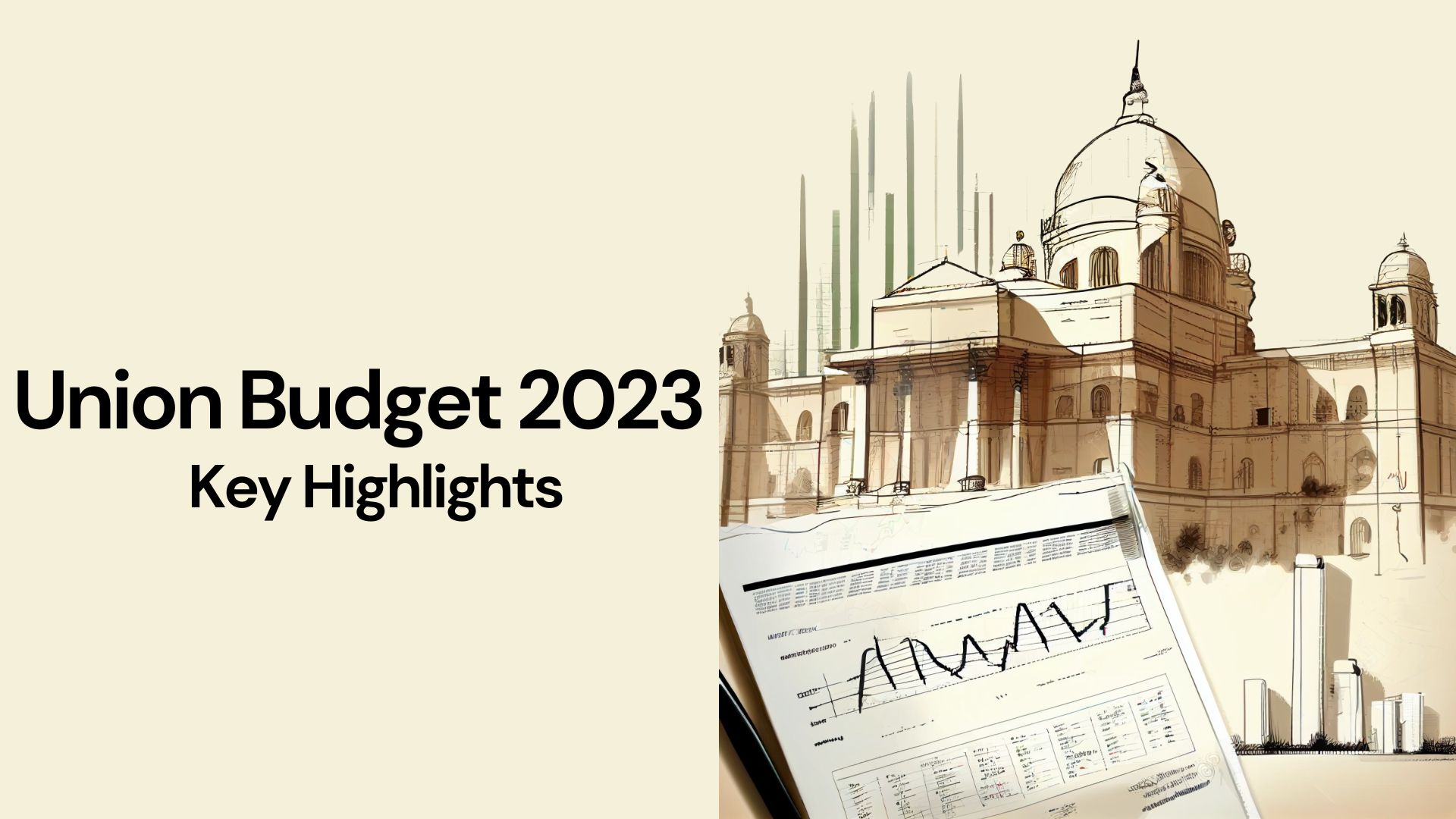Union budget 2023
Union Finance Minister, Nirmala Sitharaman is presenting the Union Budget 2023 for the 5th time in a row. She will be presenting the financial statements and tax proposals for the fiscal year 2023-24 (April 2023 to March 2024). A Made in India tablet has replaced the traditional ‘Bahi Khata’ as Union Finance Minister Nirmala Sitharaman leaves the Finance Ministry’s office to go to the Parliament to present the Budget.
The Economic Survey 2022-23 was released on 31st January 2023 by the Chief Economic Advisor of India, V Anantha Nageswaran. The government sees the Indian economy growing at 6.5 per cent in the financial year 2023-24 (FY24).
This is the first budget in ‘Amritkal‘ This Budget hopes to build on the foundations laid in the previous Budget and the blueprint drawn for India@100. Indian economy is on the right track and heading towards a bright future. The Budget 2023 focuses on seven priorities, which the FM called the “Saptrishis guiding us through Amrit Kaal”.
7 Priorities of Budget2023
- Inclusive development
- Reaching last mile
- Infrastructure and investment
- unleashing potential
- Green growth
- Youth Power
- Financial Sector
Budget and Constitutional Provisions
- The Union Budget is the yearly financial report estimating the income and expenditure presented to outline future policies to be adopted by the government for sustainable growth and development.
- According to Article 112 of the Indian Constitution, the Union Budget of a year is referred to as the Annual Financial Statement (AFS).
- It is a statement of the estimated receipts and expenditure of the Government in a Financial Year (which begins on 1st April of the current year and ends on 31st March of the following year).
- The Budget Division of the Department of Economic Affairs in the Ministry of Finance is the nodal body responsible for preparing the Budget.
- The first Budget of Independent India was presented in 1947.
Here are the key highlights from the Union Budget 2023-24:
Income Tax Slabs Budget 2023
The new income tax slabs under new tax regime
- Rs 3 lakh: NIL
- Rs 3 lakh- Rs 6 lakh: 5%
- Rs 6 lakh-Rs 9 lakh: 10%
- Rs 9 lakh-Rs 12 lakh: 15%
- Rs 12 lakh- Rs 15 lakh: 20%
- Over Rs 15 lakh: 30%
Budget 2023: Key announcements
- FY24 gross borrowing target at ₹15.43 lakh crore
- Fiscal deficit target for FY24 pegged at 5.9%
- Fiscal deficit for FY23 estimated at 6.4% of GDP
- Fiscal deficit glide path for FY26 is 4.5%
- increase on duties on silver doors, bars at par with gold
Mission Karmayogi
- Under Mission Karmayogi, Centre, States and Union Territories are making and implementing capacity-building plans for civil servants. The government has also launched an integrated online training platform, iGOT Karmayogi, to provide continuous learning opportunities for lakhs of government employees to upgrade their skills and facilitate people-centric approach.
- For enhancing ease of doing business, more than
39,000 compliances have been reduced and more than
3,400 legal provisions have been decriminalized. For furthering the trust-based governance, we have introduced the Jan Vishwas Bill to amend 42 Central Acts. This Budget proposes a series of measures to unleash the potential of our economy.
Centres of Excellence for Artificial Intelligence
For realizing the vision of “Make AI in India and Make AI work for India”, three centres of excellence for Artificial Intelligence will be set-up in top educational institutions. Leading industry players will partner in conducting interdisciplinary research, develop cutting-edge applications and scalable problem solutions in the areas of agriculture, health, and sustainable cities. This will galvanize an effective AI ecosystem and nurture quality human resources in the field.
Lab Grown Diamonds
- Lab Grown Diamonds (LGD) is a technology-and innovation-driven emerging sector with high employment potential. These environment-friendly diamonds which have optically and chemically the same properties as natural diamonds. To encourage indigenous production of LGD seeds and machines and to reduce import dependency, a research and development grant will be provided to one of the IITs for five years.
- To reduce the cost of production, a proposal to review the custom duty rate on LGD seeds will be indicated in Part B of the speech.
Budget 2023: Important Points
- In the 75th year of our Independence, the world has recognised the Indian economy as a ‘bright star’. Our current year’s economic growth is estimated to be at 7 per cent.
- The rebate under section 87A of new income regime hiked to Rs 7 lakh, says FM
-
Senior Citizen Savings Scheme: Maximum investment limit increased from Rs 15 lakh to Rs 30 lakh, announces FM
- DigiLocker will now be a one-stop KYC maintenance system for individuals, allowing you to make changes to papers that will be reflected in all of your documents that are linked to digilocker, Budget 2023 announced.
- The recently launched National Green Hydrogen Mission, with an outlay of 19,700 crores, will facilitate transition of the economy to low carbon intensity, reduce dependence on fossil fuel imports, and make the country assume technology and market leadership in this sunrise sector. Our target is to reach an annual production of 5 MMT by 2030.
- The revised fiscal deficit is at 6.4 per cent of the GDP.
- The government plans to introduce a 5 per cent compressed biogas mandate for all entities marketing natural gas in India.
- Revamped credit guarantee scheme will take effect from April 1, 2023, through the infusion of Rs 9,000 crore in the corpus. This will enable additional collateral-free credit of Rs 2 lakh crore to MSMEs.
- The government will launch Pradhan Mantri Kaushal Vikas Yojana 4.0. In order to skill the youth for international opportunities, 30 Skill India International Centres will be set up across different States.
- 50 additional airports, heliports, water aerodromes, and advanced landing zones to be revitalised. 100 critical transport infra projects for steel, ports, fertiliser, coal, foodgrain sectors have been identified with an investment of Rs 75,000 crore including Rs 15,000 crore from private sources, the Finance Minister announced.
- Average processing time for ITRs reduced from 93 days to 16 days.
- Credit guarantee for MSME, revamped scheme will take effect from April 1, 2023 with infusion of ₹9,000 crore corpus. Cost of Credit tp be reduced by 1%.
- The Centre will recruit 38,800 teachers and support staff for 740 Eklavya Model residential schools serving 3.5 lakh tribal students
- All cities and towns will be enabled for 100% mechanical de-sludging of septics tanks & sewers to transition from manhole to machine hole mode
- The outlay for Pradhan Mantri Awas Yojana is being enhanced by 66% to over ₹79,000 cr.
- Centre will launch the ‘Dekho Apna Desh’ initiative to promote domestic tourism.
- One-time new small saving scheme Mahila Samman Saving Certificate will be made available for two years up to 2025.
- Finance Minister Nirmala Sitharaman proposed increase in the agriculture credit target in the Budget 2023 to Rs 20 lakh crore, with an emphasis on industries such as animal husbandry, dairy and fishery. She also proposed a sub-scheme of PM Matsya Sampada Yojana with a targeted investment of Rs 6,000 crore.
- Taxes on cigarettes hiked by 16 percent.
- Basic import duty on compounded rubber increased to 25 percent from 10 percent.
- Basic customs duty hiked on articles made from gold bars.
- Customs duty on kitchen electric chimney increased to 15 percent from 7.5 percent.
- Customs duty on parts of open cells of TV panels cut to 2.5 percent.
- Govt proposes to reduce customs duty on import of certain inputs for mobile phone manufacturing.
- FM Sitharaman has proposed an outlay of Rs 35,000 crore to achieve energy transition and net zero objectives and listed green growth among seven priorities of the government.
- PM PRANAM – Programme for Restoration, Awareness, Nourishment and Amelioration of Mother Earth will be launched to incentivise states and UTs to promote alternative fertilisers.
- The Jan Vishwas Bill has been introduced to amend 42 central acts & unleash the potential of our economy.
- The minister announced the launch of ‘Atmanirbhar clean plant program’ to provide clean and quality material for horticultural crops at an outlay of ₹2,200 crores.
- Relief in customs duty on import of certain parts like camera lens.
- Maximum Deposit Limit for Senior Citizen saving scheme to be increased from 15 to 30 lakhs.
- Deductions from capital gains on investments in residential houses to be capped at Rs 10 crore.
- Concessional basic customs duty of 2.5% on copper scrap to continue; customs duty on shrimp feed to be decreased.
- The basic import duty on compounded rubber increased to 25% from 10%.
- Support to be provided for setting up of battery energy storage of 4,000 MwH.
- The 50-year interest-free loans provided to state governments to be extended for one more year.
- Urban planning to be encouraged, with a focus on 100 critical transport infrastructure projects, 100% transition of sewers and septic tanks from manhole to machine hole mode.
- The outlay for PM Awaas Yojana has been enhanced by 66 per cent to over Rs 79,000 crore.
- Capital investment increased for the third year by 33% to 10 lakh crores, 3.3% of GDP.
- A national cooperative database is being created to map cooperative societies.
- In the drought prone central region of Karnataka, central assistance of 5,300 crore will be given to Upper Bhadra Project to provide sustainable micro irrigation and filling up of surface tanks for drinking water.
- The outlay for PM Awas Yojana is being enhanced by 66 per cent to over ` 79,000 crore.
- ‘Bharat Shared Repository of Inscriptions’ will be set up in a digital epigraphy museum, with digitization of one lakh ancient inscriptions in the first stage.
- For poor persons who are in prisons and unable to afford the penalty or the bail amount, required financial support will be provided.
- States and cities will be encouraged to undertake urban planning reforms and actions to transform our cities into ‘sustainable cities of tomorrow’. This means efficient use of land resources, adequate resources for urban infrastructure, transit-oriented development, enhanced availability and affordability of urban land, and opportunities for all.
- Like the RIDF, an Urban Infrastructure Development Fund (UIDF) will be established through use of priority sector lending shortfall. This will be managed by the National Housing Bank, and will be used by public agencies to create urban infrastructure in Tier 2 and Tier 3 cities. States will be encouraged to leverage resources from the grants of the 15th Finance Commission, as well as existing schemes, to adopt appropriate user charges while accessing the UIDF.
- For the business establishments required to have a Permanent Account Number (PAN), the PAN will be used as the common identifier for all digital systems of specified government agencies. This will bring ease of doing business; and it will be facilitated through a legal mandate.
- For efficient administration of justice, Phase-3 of the E-Courts project will be launched with an outlay of 7,000 crore.
- This is among the highest in the world. The finance minister proposed to reduce the highest surcharge rate from 37 per cent to 25 per cent in the new tax regime. This would result in reduction of the maximum tax rate to 39 per cent.




 PM Modi Receives Oman’s Highest Honour, ...
PM Modi Receives Oman’s Highest Honour, ...
 Who Is Sai Jadhav? India’s First Woman O...
Who Is Sai Jadhav? India’s First Woman O...
 India and Saudi Arabia Sign Visa Waiver ...
India and Saudi Arabia Sign Visa Waiver ...







